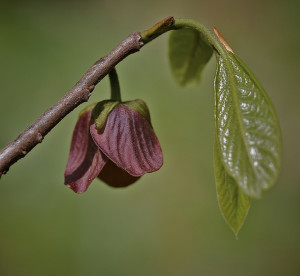
Not all pawpaw blossoms are white. Photo by Susan Wiltse.
Pawpaw are blossoming. Where’s the best place to spot them? Pastures. Look for a five-foot shrub with creamy manolia-texture flowers. But also don’t forget to look down. Often along a fence there will also be dwarf pawpaws with purple blossoms. Another good place to look is at the base of tall pine trees. I suppose creatures that eat pawpaws eat them in the trees and drop the seeds which then grow at the base of the pine. To read more about pawpaws go here.
The most common general question I receive is: Are there any poisonous look-alikes? The answer is yes and no. No if you look close enough, yes if you do not.
Ripe BB-size elderberries. Photo by Mother Earth News.When a novice forager misidentifies a plant it is usually because they are focusing on one thing about the plant and ignoring other key points that would tell them they’ve got it wrong. The person is often working from Internet pictures and or a guidebook. That poses two immediate problems. One is a matter of scale. Berries, for example, are rarely true to scale in pictures so small berries can look big and big ones small. The other issue is where and when was the picture taken. I have a professional grade book written by a botany professor and even I would not recognize his photograph of a lamb’s quarter. In fact, it is the worse photograph of that species I have ever seen. How many of his students (who have to buy the book for his class) get understandably confused when they get to that plant?
Let me give you four examples of misidentification, two I hear about often and two that happened this past week: Elderberry and Poke Weed, Purslane and Amaranth, Purslane and Evening Primrose, Bittercress and Oxalis.
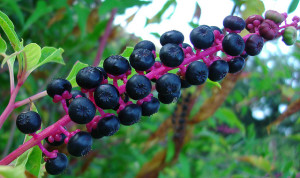
Pea-size pokeweed berries, NOT EDIBLE. Photo by Laura Hayes
Elderberry and Pokeweed have green berries that ripen to dark purple to black, have many seeds, and both plants can grow quite large. That’s it. That is how people get the two confused. What don’t the see? First the berries are different size, one about BB size the other like a big pea plus they are arranged differently. Elderberries are in a flat-top cluster (marine haircut) pokeberries are a raceme (think bottle brush with berries.) Elderberry leaves are skinny with small teeth (think double sided serrated knife.) Pokeweed had big elliptical leaves, no teeth. Elderberry is a shrub with bark. Pokeweed is herbaceous with a stem that eventually turns red. There are more differences but if one only notices berries and doesn’t even consider size and shape the mistake is made.
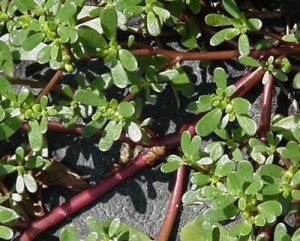
Purslane has round fleshy stems. Photo by Homestead Revival
Purslane and Amaranth have very little in common. They are very different plants. Purslane is low-growing, succulent looking, spatchula-shape leaves with no teeth, yellow blossoms, and little barrels for seed pods. Amaranth grow several feet tall, has minute green blossoms, cones of seeds, and big leaves with large teeth or lobes. How do they get confused? They can both have a pink stem. Even then there are differences. The purslane stem is round and breaks easily, the amaranth stem aer often grooved and tough. But what happens is the forager either see a young, small amaranth, or one that has been mowed into short statue and then the pinkish stem so they identify it as purslane.
Confusing Purslane and Evening Primrose is even more of a stretch. They both are low growing and have yellow flowers. But the Evening Primrose flower is three times as large and (locally) it has hairy leaves, purslane absolutely does not. But a picture of our low Evening Primrose taken while standing makes the blossom appear small thus the confusion unless you read what size the blossom is supposed to be (that is why there are written details with photos. Photos alone are not enough.)
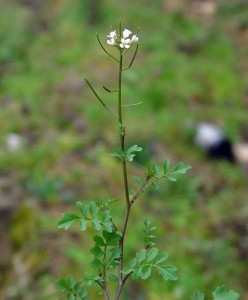
Bittercress has white blossoms and tooth-pick seed pods. Photo by Northern Bushcraft.
What do Bittercress and Oxalis have in common? Part of their seed casing. Plants in the mustard family have seeds on stems. With the Bittercress the seeds look like little tooth picks on stems, many of them. The Oxalis produces a seed pod that kind of looks like a stork’s bill. Some Oxalis have yellow blossoms so the mustard confusion is clinched even though Bittercress has white blossoms. A quick look at the leaves or tasting them easily separates the two. Oxalis leaves look like what most people would call a shamrock, Bittercress is more like little arugula leaves. Bittercress tastes peppery, Oxalis tart.
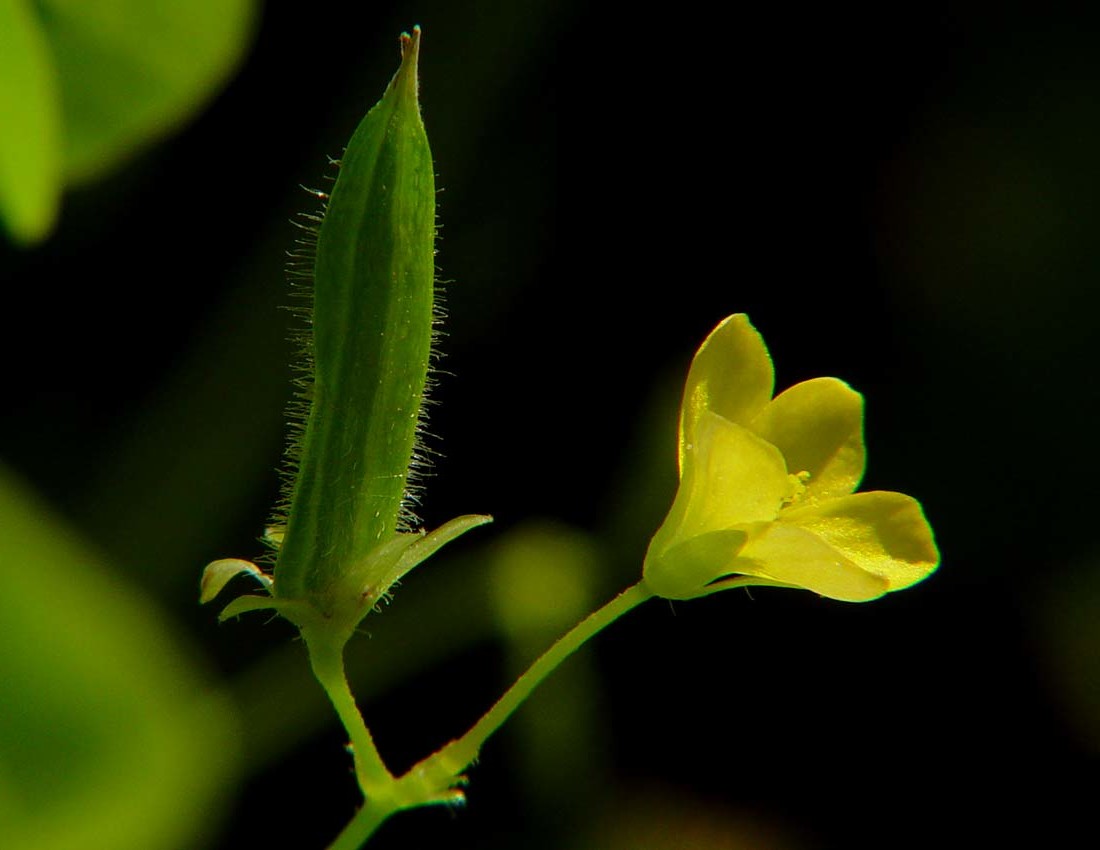
Oxalis seed pod is shorter, fatter than Bittercress. The blossom is also yellow. Photo by Flora.nhm
One way to usually sort out plants easily is look at the blossom. No matter how stressed a plant might be the blossom is usually true to form. Look for the number of petals, color, are the petals separate or fused, does it have bracts and what color are they? Other quick identifying marks are leaf shape, arrangement of teeth on the leaves, or no teeth, what’s the arrangement of the leaves on the main stem and how do they attach to the main stem?
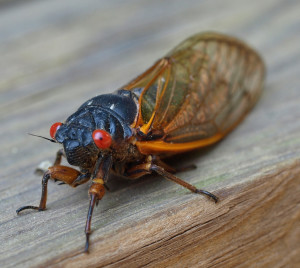
17-year Cicadas are about to emerge. Photo by Learnnc.com
If you live in New Jersey or thereabouts get ready for an invasion of food: The Cicadas (see-KAY-dahs) are digging out. Like clockwork, they’re emerging from their 17 years in the ground. They live underground and feed off fluid that gathers near the roots of plants. Once every 17 years they emerge from the soil when its temperature reaches 64 degrees. This is the 17th year. They’re harmless and edible though they do make a lot of noise (easy to find.) Some areas could see as many as a billion of the Cicadas per square mile. Yum. Practice foraging for them this time or wait another 17 years.
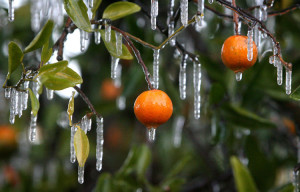
It even gets chilly in Florida now and then. Photo by the Orlando Sentinel.
Does one need to comment on the weather? Several cold-weather species that are usually gone for the season by now are still here. I am still finding chickweed in sunny spots. Unheard of. Stinging Nettles (Urtica) are still growing! I don’t think I’ve ever found them this late in the seasons. Tis the same with Pellitory. Usually by now I find it only in deep shade, but there are still opportunistic patches catching sun. Also by now the Mulberries have fruited and gone past season but this last weekend I saw a Mulberry that is still putting on unripe green fruit. On the coast the Surinam Cherry is edible. Here inland my Surinams are small and green still. Whether this is just a result of this year’s weather or a long trend reminds to be seen but it has been colder longer than usual.

From French restaurants to the campfire frog legs are tasty fare. Photo by Frog Legs.org.
Man with fear of frogs awarded $1.6 million …. and we thought they were just edible. CLARENCE, N.Y. — Paul Marinaccio Sr. traces his fear of frogs to a childhood incident in Italy when a man holding bullfrogs chased him away after he’d wandered from the vineyard where his parents worked.
Decades later, he found himself describing his phobia to a jury, calling himself “a prisoner in my own home” after runoff water from a nearby development turned his 40-acre property into wetlands and inundated it with frogs.
“I am petrified. I go home at night and I can’t get in my garage because of the frogs,” Marinaccio testified in 2009. “They’re right in front of the damn door, OK?”
It was part of a seven-year legal fight involving Marinaccio, the town of Clarence and a developer that, according to The Buffalo News, finally ended last month when the state’s highest court ruled that Marinaccio, who was awarded $1.6 million in compensation after the 2009 trial, is not entitled to an additional $250,000 in punitive damages.
Marinaccio sued Clarence, a Buffalo suburb, and Kieffer Enterprises Inc. after runoff diverted onto Marinaccio’s property from a new Kieffer subdivision turned it into wetlands. A town engineer initially said the water would flow into a ditch elsewhere on Kieffer property. The town later discovered the ditch was actually on Marinaccio’s property, and that it was too small to handle the flow of water.
Lawyers on both sides said Monday that Marinaccio’s frog testimony amounted to just moments of a more than three-week trial – and may not have affected the jury’s award. The Court of Appeals, however, referred to it in a five-page decision in which it determined that while Marinaccio had been wronged, the developer hadn’t acted maliciously.
“This newly created wetland caused mosquitoes to breed and frogs to gather on plaintiff’s property, about which plaintiff is particularly phobic,” the court wrote in an opinion dated March 21. “Consequently, plaintiff had problems traversing his property without the assistance of his family and friends, whom plaintiff would often call on to remove frogs from his driveway and near the door of his home.”
“I’m petrified of the little creatures,” Marinaccio, 65, said in Monday’s Buffalo News.
The lower court jury returned a verdict of $1.3 million against the town and $328,400 against Kieffer for compensatory damages, as well as $250,000 in punitive damages against Kieffer.
In reversing the punitive damages, the Court of Appeals said they are awarded only when there is evidence “of spite or malice, or a fraudulent or evil motive on the part of the defendant, or such a conscious and deliberate disregard of the interests of others that the conduct may be called willful or wanton.”
As part of a post-verdict agreement, the town will dig ditches to help dry out Marinaccio’s land.
The property owner told the newspaper his plans involve much bigger creatures than frogs.
“I’m going to put cows out there,” Marinaccio said.

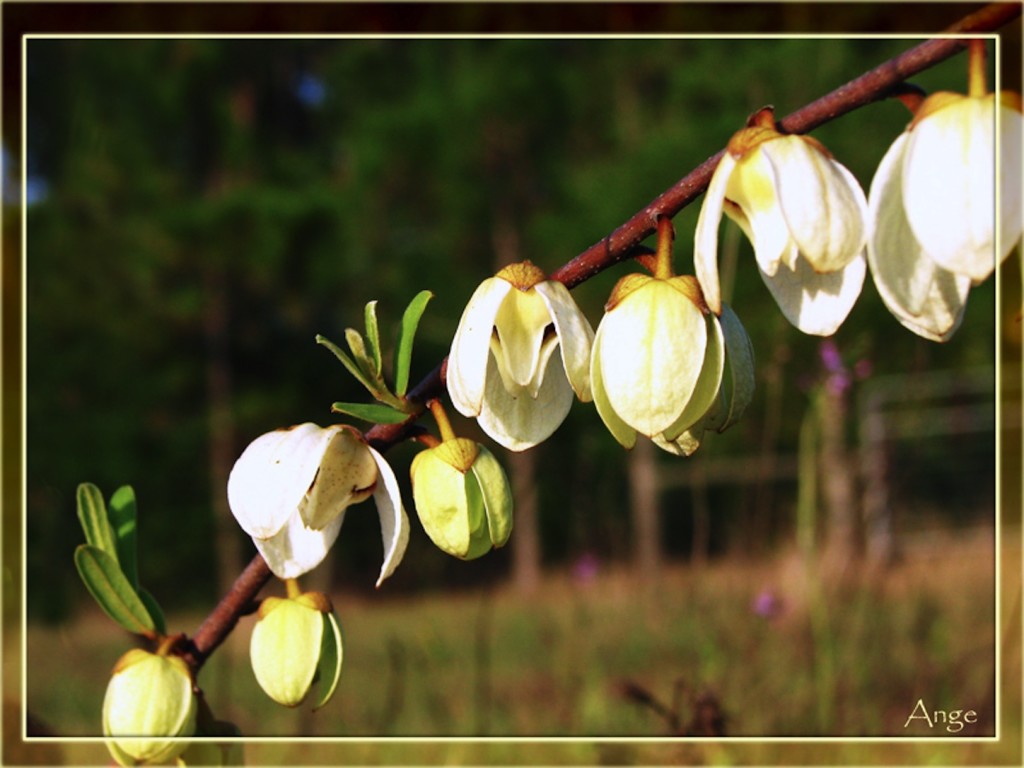
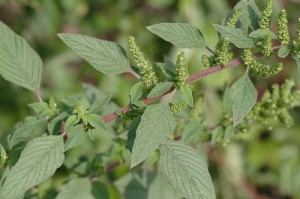

i really enjoy your writing and the information. thanks.
Amazing what plants confuse folks. Purslane and amaranth? And yet, I bet the ones I get confused would make people laugh. Anyway, I think purslane looks more like prostrate spurge (Euphorbia maculata), that stuff with the milky substance in its stems.
As for pokeweed, I think the mature plant is easy to differentiate from elderberry. Yet it is the young shoot I can’t identify until it is too tall and thus inedible. (And so I have never tasted pokeweed. Maybe someday when Green Deane visits Baltimore… in spring.)
In general, my problem with identifying many plants is identifying them when they are young and tender. I can identify them when they are older, but by then they aren’t as edible. And many of these, like poke, don’t grow in the same spot each year.
I have learned my regular edible weeds because they grow all over and I take note of them. When I see a patch of grass I no longer see just green, the individually shaped leaves and stems of each plant reach out too me as if to shake my hand. Hello again Mr. Plantain, Mr. Sow Thistle, Mrs. Chickweed, Mrs. Sorrell and Mr. Clover. Aren’t you looking mighty fine today. To bad your next to the road or in the sidewalk crack or sewage ditch. I sure would have liked to bring you home with me. Seams I can identify them 100% now but good healthy locations are HARD to find. 🙁 Any suggestions?
Yum! Frog legs! I ate many of those growing up in the swamps of south Louisiana. 🙂 Great newsletter as always. Thanks, Deane, for your hard work.
Cant wait for the 17 year feast here in Maryland.
Recipes here:
http://www.newsdesk.umd.edu/pdf/cicada%20recipes.PDF
Had I not”looked close enough & considered all key points ” , I might have wrongly thought our native edible fruit “Hunbook”i.e. Capparis decidua ( pictured on internet a collection of fruits as if a cluster) to be the Red elderberry pictured on Newsletter 9 April 2013. Indeed “Not all that glitters is gold.” Unlike Cigadas, flying ants which we watch each year in day light – here in Sudan – immediately after first rainfall of the rainy season, “ooze” from ground and scatter in the sky in thousands like firework. Some do’nt continue travel as their fate will be the gills of colourful birds migrating from Ethiopia & south east Africa , camping in crowds close to their holes; the same destiny is awaiting the rest – this time by vultures (Aquila rapux) if not by Saddelebilled storks hovering high up in the sky. Wonderful life – feast for Cigadas yet “jumping out of the frying pan into the fire” for the flying ants. Paul Marinnacio Sr.was able to trace his frog phobia & was fortunate enough. How unfortunae we were as a couple spending a whole night sleepless in a tourist hotel in an East Asian country because of ” enherited” lizard phobia of my wife, at a glance fainting on watching a lizard on the wall – Next night she was advised to close her eyes before going to bed.
saw this interesting book about australian succulent plants and it had a summary of edibles
http://australiansucculents.com/edible-succulents
I live in North Carolina. When the 17-year cicadas emerged some years ago, my dogs loved to catch them as they flew up from under their feet — and eat them. So now I read that human beings enjoy eating them, too! (However, I doubt that I would want to try cooking or eating one.)
You said concerning the cicadas: “Practice foraging for them this time or wait another 17 years.” I know they remain in the nymph state for 17 or 13 years (depending on the species), but don’t they hatch in different years, so that each year will see the same amount as any other?
Although… Three years ago, there was a hatch here in north Alabama in April, and they were smaller and had red eyes and orange wings, like your picture. All other years, they hatch late July into August, are large with green eyes and gray wings.